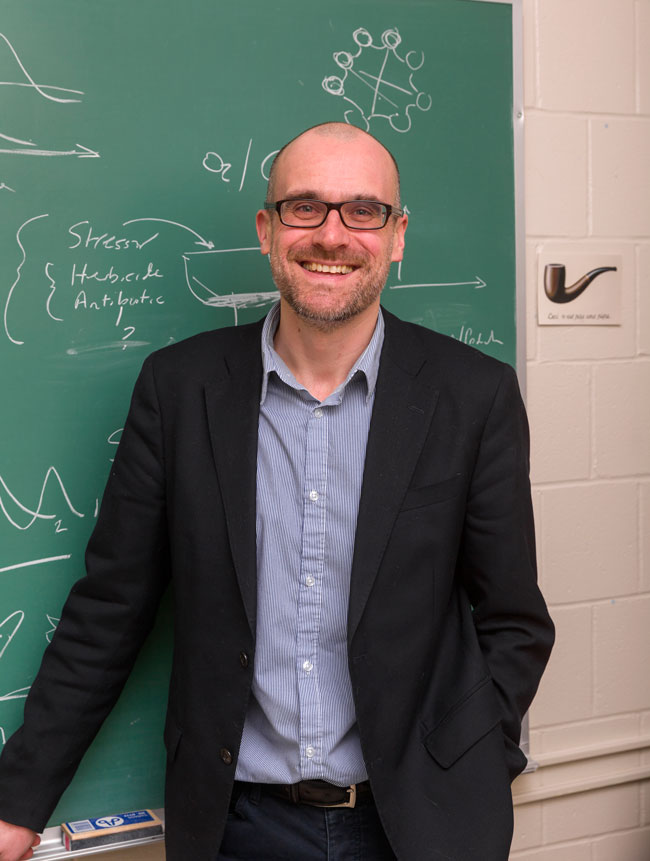
The Annual Meeting of the World Economic Forum will take place on Jan. 17 – 20, in Davos-Klosters, Switzerland. Over 2,500 leaders from business, government, international organizations, civil society, academia, media and the arts will convene under the theme Responsive and Responsible Leadership.
McGill, led by Principal Suzanne Fortier, will be the only Canadian university member of the Global University Leaders Forum. Principal Fortier will host an IdeasLab led by two researchers from the Faculty of Science and one researcher from the Faculty of Agricultural and Environmental Sciences, on the theme Shaping a Sustainable World.
In advance of his presentation at the Forum, Andrew Gonzalez, from the Department of Biology, talks to the Reporter about the ways in which dense urban areas have caused a serious disconnect between ecosystems. This disconnect can have a negative impact on people’s wellbeing as healthy, connected ecosystems can improve everything from air quality to urban heat extremes. However, says Gonzalez, if urban planners rethink the design of cities to make them more sustainable, this connectivity can be restored and our quality of life can be improved.
You work on biodiversity and ecosystems. Why are they such an important part of urban sustainability?
Cities are the crucible of social and ecological change. Today half of the world’s population live in cities. Although cities cover less than three per cent of the land area they use 80 per cent of the Earth’s resources. Cities rely upon the resources and goods produced by ecosystems both within the city and at regional and global scales. Today, cities form a vast global network and their development relies upon flows of energy, goods, people and information.
The replacement of ecosystems by the built environment as cities sprawl disconnects ecosystems. This ecosystem fragmentation has eroded biodiversity and the many benefits urban ecosystems supply in the form of ecosystem services. For example, ecosystems mediate air quality, storm water run-off, and urban heat extremes. All these ecosystem services affect human wellbeing. Ecosystems also make cities more resilient to the impacts of climate change.
How did your research address this challenge?
My research group at McGill has shown theoretically, and with experiments in the lab and field, that disconnecting networks of ecosystems can drive unsustainable biodiversity loss which impacts their adaptability in the face disturbance. But, by reconnecting critical nodes and links to create an ecosystem network we can restore some of these properties, in time.
In 2009, I was asked by the Quebec government to apply this research to the design of an ecosystem network for Montreal and the surrounding region. To meet respond to this request, we assembled a large team of researchers and used data on land cover, the quality of habitat for many species, and projections from regional climate models, and land use change models to quantify the connectivity of Montreal’s ecosystems today and into the future.
Our model ranks the contribution of each ecosystem fragment to the connectivity of the entire ecosystem network in and around the city. This information is being used to optimally allocate resources to preserve and restore the city’s biodiversity and ecosystems in the form of a greenbelt conceived as a living network.
How did you translate this science into action?
In Montreal, we are partnering with the Quebec government, municipalities, and environmental NGOs, like the David Suzuki Foundation and Nature Action Quebec, to ensure that our results guide the protection and restoration of the city’s greenbelt. One project (ILEAU), lead by the Conseil Regional Environnement Montreal, has engaged businesses, schools and citizens to plant nearly 15,000 shrubs and trees with the aim of mitigating urban heat islands in East Montreal. ILEAU is benefiting the people living and working there, and this new vegetation is also restoring the ecological connectivity of this heavily built up region of the city.
This partnership has been forged by continual communication, through social media, but also by giving presentations to our partners. This has helped us integrate our research findings into the long-term process of urban planning in and around Montreal.
What do we need to do in the cities of the future?
This science can be applied to any city. Maintaining ecosystem connectivity as cities develop is crucial to meeting the challenges of urban sustainability this century. By 2050, 70 per cent of the world’s 9 billion people will be living in cities. Growing urban populations need the many benefits ecosystem can provide.
We must rethink the design of cities to acknowledge that they are mix of natural and built systems. We must design them so that they are ecologically and socially sustainable, reflecting the needs of their population, and the myriad other forms of life within urban ecosystems. This will help cities adapt to climate change and other environmental risks as they grow and develop.
Watch Andrew Gonzalez talk about his research by clicking the thumbnail below.
